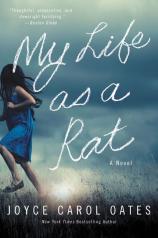My Life as a Rat
Review
My Life as a Rat
The Kerrigan household is full of tension. The working class family, living in South Niagara, New York, is lorded over by the handsome, powerful and hot-tempered Jerome Kerrigan. His wife, Lula, has seen her value reduced in her husband’s eyes after years of caring for their seven children. Of proud Irish-American stock, with potent ties to the Catholic Church, the Kerrigans and their extended family are like a universe unto themselves in their upstate town. But their tightly held secrets --- violence, fear, doubt, infidelities and bigotries --- are threatened with exposure in the fall of 1991 when one of them is seen to turn against the rest.
MY LIFE AS A RAT marks the return of Joyce Carol Oates to familiar regional and thematic territory. It is the story of Violet Rue Kerrigan --- the youngest of the siblings, who, after a moment of brutal honesty, is cast out from her home and family, scapegoated for her truth-telling --- and the life of abuse and loneliness she leads growing up alone.
"A beautiful and frightening novel, even with its gaps and liberties taken, it leaves readers with a sorrow and a cautious hope for Violet’s survival."
Often, when her father or older brothers were out late, Violet stayed awake, waiting for their return. One night, the 12-year-old hears two of her brothers, Jerome Jr. and Lionel, come home after a night out. But their sounds are unusual, so she creeps to the kitchen to eavesdrop. They are more than agitated, and she surmises that they were in a fight. However, when they bury a baseball bat outside the house, she knows it was no ordinary scrape. News of the murder of an African American high school boy named Hadrian Johnson, run down on his bicycle, beaten into unconsciousness and left by the side of the road, stuns the town. But the horrific crime, one that heightens already fraught race relations, dovetails with what Violet witnessed the night her brothers came home anxious and upset.
When Jerome and Lionel are arrested on suspicion of Johnson’s murder, the family closes ranks. But Violet, distraught and sick at school one day, suffering from injuries inflicted on her by Lionel, shares that her brothers are guilty. She is taken directly to a children’s home to protect her from them, and her father never speaks to her again. Eventually Violet goes to live with her mother’s sister, but her life with her aunt and uncle is sad and mostly solitary, and she has little opportunity to process her trauma. Instead she becomes, again and again, the victim of men who believe they see a weakness or vulnerability in her. All the while, she pines for home, for her family, and hopes to be forgiven. Violet never committed a crime but is penalized and punished all the same.
In MY LIFE AS A RAT, Oates favors response over insight, emotion over analysis. The Kerrigans, apart from Violet, are representative types more than fully fleshed-out characters. But they feel terrifyingly real as they refuse to take responsibility for their own actions and crimes, choosing instead to banish Violet. She answers back with a compassion the Kerrigans don’t deserve and a heartbreaking desire to be loved by them and invited back home. Oates’ idiosyncratic style is dreamy in its breathless tenderheartedness and just as often nightmarish in its honest detailing of a variety of abuses, prejudices and violence.
Race, gender, family loyalty: Oates tackles them all here. Like Violet’s vision of her family, MY LIFE AS A RAT is painfully sharp but fuzzy around the edges. A beautiful and frightening novel, even with its gaps and liberties taken, it leaves readers with a sorrow and a cautious hope for Violet’s survival.
Reviewed by Sarah Rachel Egelman on June 7, 2019
My Life as a Rat
- Publication Date: May 5, 2020
- Genres: Fiction
- Paperback: 416 pages
- Publisher: Ecco
- ISBN-10: 0062899848
- ISBN-13: 9780062899842




